Please Note: Firefox and some other search engines are not suitable
– Use “Internet Explorer” for this page to load perfectly!

Click the
logo above to reach the Cruise-Australia FrontPage for News Updates &
“Ship of the Month”
With Reuben Goossens
Maritime
Historian, Cruise‘n’Ship Reviewer, Author & Lecturer
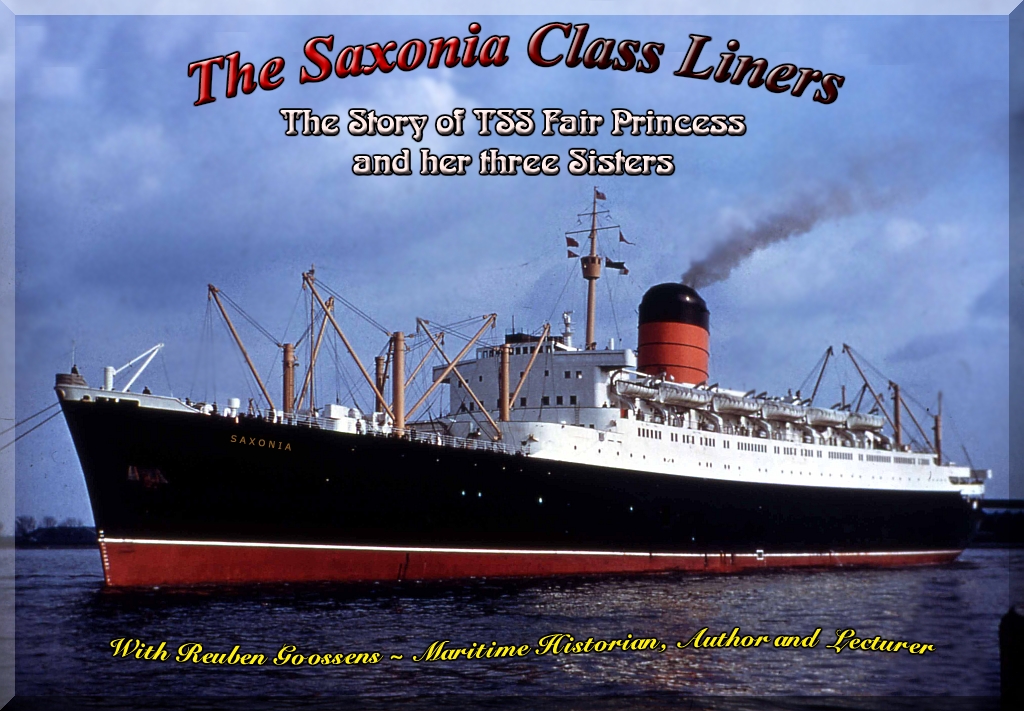
Photograph of RMS Saxonia sold to become a Russian cruise ship
From the author’s
collection
Introduction
This feature entitled “The
Saxonia Class Liners” is the result of a lecture I gave aboard TSS Fair
Princess, on Tuesday February 8, 2000, cruising between Wellington
and Auckland, whilst the Fair Princess was on
her final New Zealand cruise
from Sydney.
However, at the time we did not know that she would never return to Auckland,
for she was due to return to New Zealand and be based there later in 2000, but
I will return to that subject at the appropriate time in this multipage
feature.
However, I trust that you, like the thousands
who have already visited this feature will thoroughly enjoy reminiscing the
days of these four fine passenger liners that were indeed real ships, and what
is more, they felt like ships!
With the passing of ships like these, we will
never see the like again, for the truth is that the modern cruise ships of
today are designed more to be luxury floating resorts that look like condominiums
(apartment blocks) and so many of this vessels, I hardly even wish to call them
ships anymore, inside many look and feel more like shopping centres. In
addition, in the days of the liner and the classic cruise ship everything was
included, meaning all your food, morning bouillon or tea as well as afternoon
tea or coffee, as well as late night snacks or a buffet, plus you three main
meals per day. The only extras were your drinks, hair dresser,
items at the shop, photographer and optional tours. But today you go on a
cruise and there are all sorts of optional restaurants and cafes, some ships
even have lounges that demand a fee in order to go in to buy a drink. Then
there is the private, so called “child free” sun deck which they
may call “The Oasis”, which comes at a cost of course. The biggest
problem is that Cruise companies are run by accountants and not shipping
people. Bring back the days of genuine shipboard life!
However, I do have some good news, for there
is one cruise company that I know about which continues all the classic
traditions as well as using classic ships, which have been fully modified and
kept up to date with the very latest SOLAS 2010 fire and safety regulations,
the most modern navigational equipments and so on! This company offers all inclusive fares just like it used to, and they have a
fleet of superb classic ships! If you want to know who this company is, visit
my “Classic
Ocean Voyages” feature - after you have read this
feature.
You will find that this feature “The
Saxonia Class Liners” is spread over a number of pages and each page will
offer a variety of photographs relevant to the time and the ship in question.
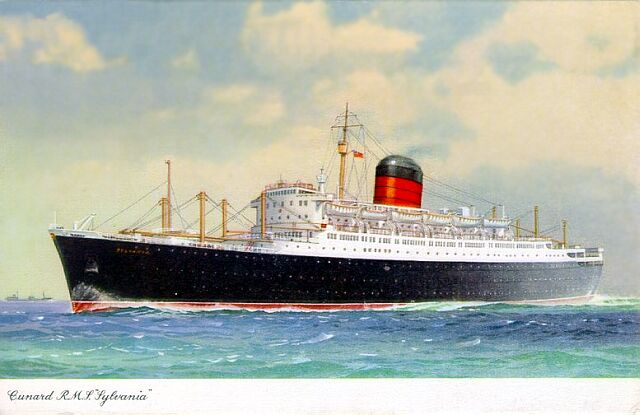
One of a series of
Cunard postcards RMS Sylvania
From the author’s collection
Foreword
In history, great dramas have
unfolded on both land and sea. Vessels of all shapes and sizes have been built over
the ages as men desired to reach the far corners of the earth. This developed
into the building of many great ocean liners producing a proud maritime
history, which continues to this day as we witness the launching of vessels
that are well over 200,000 GRT (tons) and these are the modern so-called super
cruise ships. Although these vessels may offer amenities far superior to those
that were offered on the liners of yesteryear, these ships in many ways do not
measure up when it comes to the most important issue - their sea going
capabilities. This has been proven by a number of these new ships such as the
Cunard MV Queen Victoria as per example as well as her almost identical twin
P&O’s Arcadia (which originally was supposed to have been built as
the Queen Victoria, but Carnival changed their mind). Both of these ships
behave atrociously in bad seas and the question I have been asked by their
passengers is “Why?” The answer is quite simple really, for it is
mostly due to them having been designed by the Carnival appointed maritime
engineers and designers and they have come up with what is known as the
“Vista Class Hulls.” I can tell you that these hulls have an
extremely bad reputation and this is due to their poor design, yet they have
found their way under most of the Carnival Group of Companies ships, be it
Carnival, Princess, P&O, Holland America and Costa Cruises, etc. These
ships are clearly distinguishable for their overall design, hull and
superstructure are much the same and thus includes the Queen Mary 2, which is
just a larger version of the same ship, but she, unlike the others has a dummy
stern tacked onto her totally flat stern, just for show, as well as the black
painted pretend decks on her forward superstructure, so very American, again, all
show, but it is just imitation!
Of course besides “The Saxonia Class
Liners” there were many other notable ships and you will find many of
these, over 300 of them on my main index. But this feature highlights a special
quartet and they are the subject of this work, and I hope that as we venture
into the history of these four superb ships that many happy memories will fill
the hearts of all those who have spent some time onboard them, or have seen
them and possibly visited them whilst they were in port and beheld their sheer
beauty and photographed these ships, just like I did when I saw a liner
visiting my home port, they were the great days, when you could still board any
liner without a problem, for there was little to no security, or it was easy to
get a pass from the shipping company or agent. For me, it was easy, I always
worked in passenger shipping, and thus it was extremely simple!
Reuben Goossens.
Four New Cunard Ships for
the Canadian Service
Cunard Line announced at the end of 1951 that they
had made a decision not only to build a series of new ships for the service
between Liverpool and Montreal,
but that they would be a class to themselves. The announcement was that there
to be two ships built, however, soon after an additional two ships were added.
These ships would become known and named after the first ships of the series,
“The Saxonia Class Liners.” There were a number of things that made
them special. They were the largest Cunard liners to built
to operate especially on the Liverpool to Canada service. All four ships were
built by John Brown & Co. Ltd, Clydebank, Glasgow,
Scotland, and they had to
meet the requirements of Canada’s
rapidly growing population and increasing volume of overseas trade.
For their time at 21,600 GRT they were
relatively large ships for Canadian service and each ship would have a
considerable passenger capacity offering two classes, First and Tourist that
offered traditional British style and comfort. In addition these ships had six
holds with massive cargo spaces. However, the all important
thing was to retain these ships in the dimensions that would permit them sail
safely from Quebec along the St Lawrence River
up to the Port of
Montreal and return.
Cunard officially announced their third ship
had been ordered in October 1953, this would be the Carinthia, but soon after
named their first two ships on November 25, 1953, the first ship would be named
Saxonia, followed by the Ivernia and then the Carinthia, which was followed by
the Sylvania.
Whilst the Carinthia’s
construction was underway an announcement was made by Cunard in June 1955,
stating that HRH Princess Margaret had officially agreed to preside over the
official naming ceremony. This special occasion made RMS Carinthia the 4th.ever Cunarder to be
launched by Royalty, the previous ships had been, RMS Queen Mary, launched by
HM Queen Mary, RMS Queen Elizabeth, launched by HM Queen Elizabeth and RMS
Caronia, launched by HRH Princess Elizabeth.
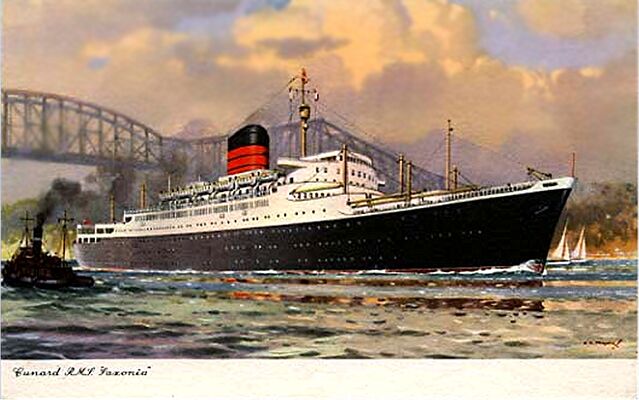
Another of
the Cunard postcards - RMS Saxonia
From
the author’s collection
Ships Original Name Gross Tons Launched Renamed
1. Saxonia 21,637 GT 17
Feb’54 Carmania/Leonid Sobinov
(scrapped at Alang India
1999).
2. Ivernia 21,717 GT 14
Dec’54 Franconia/Fedor Shalyapin/Salona
(scrapped at Alang 2004).
3. Carinthia 21,947 GT 14
Dec’55 Fairland/Fairsea/Fair Princess/China Sea
Discovery/
Sea Discovery (scrapped at Alang 2006).
4. Sylvania 21,989 GT 22
Nov’56 Fairwind/Dawn Princess/Albatros/Genoa (scrapped at
Alang 2004).
The RED NAME was the name used for the voyage to the breakers.
The fourth of the Saxonia Class ships, the Sylvania, became the very
last Cunard Liner to be designed exclusively for North the Atlantic trade. As
indicated earlier, these ships were typical of the many new passenger liners
built in their day they had excellent passenger facilities, as well as having
extensive cargo capacities. Each ship had three holds forward and three holds
aft.
These liners closely followed the Dutch
Holland America Line liners, the SS Ryndam (1951) and Maasdam (1952) were built
to have Tourist Class occupy the vast majority of the ship, with Tourist Class
offering greatly improved comforts and new facilities. Whilst First Class was a
more intimate style and a rather exclusive style of travel! Thus, we would
assume that Cunard took the idea from Holland America, as it
proved to be a huge success for that company!
Regarding the RMS (Royal Mail Ship) Carinthia
accommodated 154 to 174 First Class (pending on the use of interchangeable
cabins), and 682 to 714 Tourist Class passengers. Thus, this
made the Saxonia Class Liners, like the Dutch, were revolutionary ships for
their day!
All four ships were placed on the Liverpool, Canada service as well as operating to the USA, for they would sail to Quebec
City and Montreal.
But it would be during the icy winter months that they were rerouted on the
Liverpool, Cobh, Halifax
to New York
service.
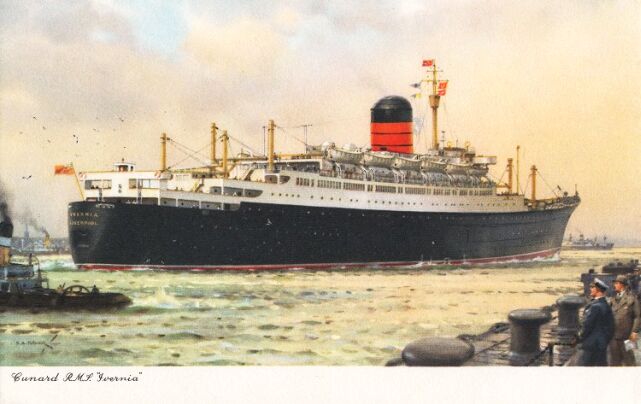
Cunard postcard –
RMS Ivernia
From the
author’s collection
RMS Carinthia
The Carinthia
was launched by HRH Princess Margaret on December 14, 1955 with pomp and great
ceremony. She made her maiden voyage from Liverpool to Montreal on June 27, 1956.
Although the Carinthia had to be built within
the maximum dimensions that would allow her to reach Montreal, which is nearly
a thousand miles up the St Lawrence waterway, she like her sisters she offered all
the traditional Cunard standards of luxury and elegance. This was particularly
noticeable in her public rooms, in which all the traditional delightful period
styles of décor were recreated. The large Tourist Class Restaurant was bright
with Pompeian decorative colourings of black, terra cotta, and green. The First
Class Smoking Room, had elegant oak-panelled walls, and her windows were
mullioned in blue hide that recalled the stout comfort of Tudor England! The
First Class Lounge reflected the elegance of 18th.century
France,
whilst the Main Lounge was decorated in Regency style.
See RMS Carinthia’s Inaugural Brochure.
Like her three sisters, the Carinthia
featured a magnificent balconied Cinema, as well as a Tourist Class Soda
Fountain for the younger travellers onboard. With the ship being fully
air-conditioned and stabilised, this ensured a comfortable Atlantic crossing
making the Saxonia sisters a popular mode of travel between the UK, Canada
and North America!
During the fifties and early sixties, they
plied the Atlantic, carrying significant
numbers of passengers. One of these being Mr. Phillip Wood, who was aged 25
when he boarded the RMS Saxonia on May 2, 1956, for a voyage from Liverpool to Montreal via Greenock and Quebec. When he wrote me in 2006 he was a
young 71 years of age, and residing in the UK. He kindly sent me several
images from the pages taken from the “Passenger List” of his
sailing as well as a drawing. These can be seen on a separate
page, see the Index at the bottom: “Passenger list images.”
Changes for Saxonia & Ivernia
These four fine liners continued to ply the Atlantic until 1962, when it was felt they needed to be
substantially upgraded. Three ships where given substantial refits between 1962
and 1965 providing them with additional features, including the installation of
private facilities to 60% of the accommodations.
After their refits the Saxonia was renamed TSS
Carmania, whilst the Ivernia was renamed TSS Franconia. The were big changes
made externally to these two these ships with a new colour scheme being the
same as the famed super luxury Cunard cruise ship SS Caronia being that well
known and much loved (by some) two tone green cruise livery. In addition, the
aft decks had been extended further aft as well as the removal of the four aft
kingposts and derricks and a pool installed. The Tourist Class Main Lounge also
being the Grand Ballroom was heightened up a full deck with a grand staircase
aft leading to the upper level surrounding balcony.
Accommodations were now as follows:
TSS Carmania: 117 First Class and 764 Tourist
Class and she was registered as being 22,592 GRT.
TSS Franconia: 119 First Class and 728 Tourist
Class, and registered at 22,637 GRT.
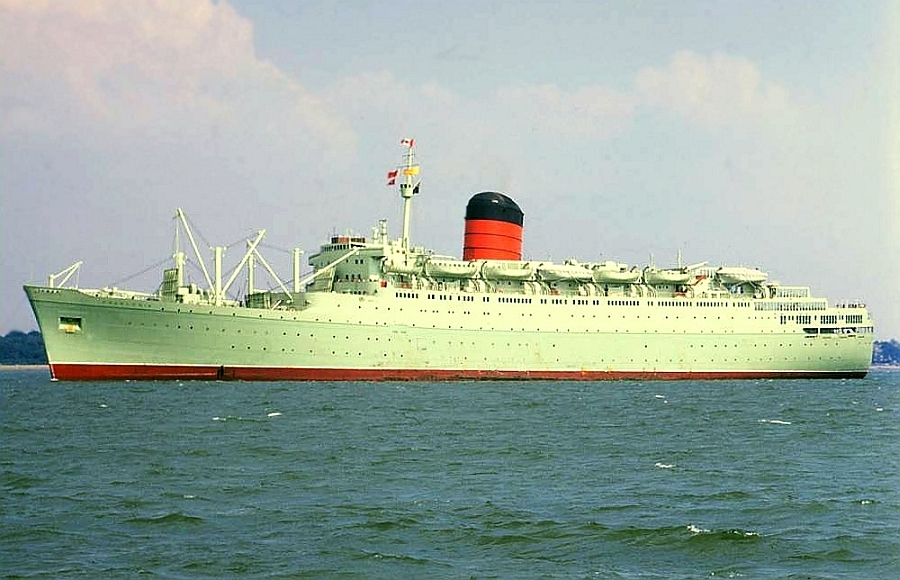
A postcard of the TSS
Carmania & Franconia in their cruise ship livery, showing their stylish new
aft extensions
From the
author’s collection
However, the green livery certainly did not
prove to be popular and in 1967 both ships were painted the more popular
cruising all white, which was a vast improvement! Considering the both ships had
already received brand new lido decks, with an attractive kidney shaped
swimming pool, with a wading pool, and floor to ceiling window enclosures on
both sides made these ships look very smart in their new white livery.
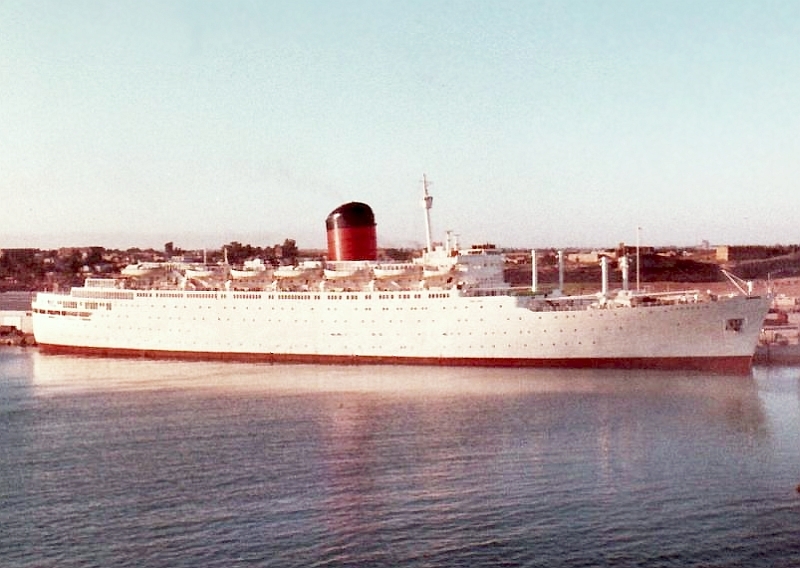
The Carmania seen in
her bright new white livery and looking rather smart!
This photo was taken at
Famagusta in Cyprus around 1970
Photograph by
© Peter Dixon
However, overall the new venture just did not
work for Cunard and these ships were losing them far too much money. With
sadness in 1971, the Carmania and Franconia
were laid up and they were both sold to the Russian buyers in 1973:
TSS Carmania (ex Saxonia) became TSS Leonid
Sobinov for the Black Sea Shipping Company flying the Russian flag until 1990
when she was reregistered in Malta.
She was laid up in 1995 in Iliychevsk Ukraine, in order for her to have mechanical
repairs and a refit, however, as many expected, who knew better, she remained
there for eight long years idle, until December 1998 when she sailed for Alang
India where she was broken up in 1999.
However, she did enjoy many years of cruising
and spent considerable time in he author’s country cruising for the 100%
Russian owned cruise Company that had its HQ in England, CIC Cruises.
Her sister, TSS Franconia (ex Ivernia) became
TSS Fedor Shalyapin for the Far Eastern Shipping Company. This ship became very
special to the author because of my close involvement with her having operated
her in Australia.
Her story can be found in a separated feature and a link is placed in the Index
at the bottom of this page – “Fedor Shalyapin.”
Carinthia & Sylvania
Out of the three ships that did receive a
refit, the Carinthia missed out on both a
refit as well as a name change and she continued on her regular Trans Atlantic
service with the occasional cruise. However, the baby of the fleet, the
Sylvania did received a refit, but sadly hers had not been quite as substantial
as the first two ships and she did not have her aft decks extended nor the Main
Lounge and Ball Room raised up a deck. But she did receive the additional
private facilities to 60% of her accommodations. In addition she also retained
her original name. From this time she operated both Trans Atlantic crossings
more regular cruises.
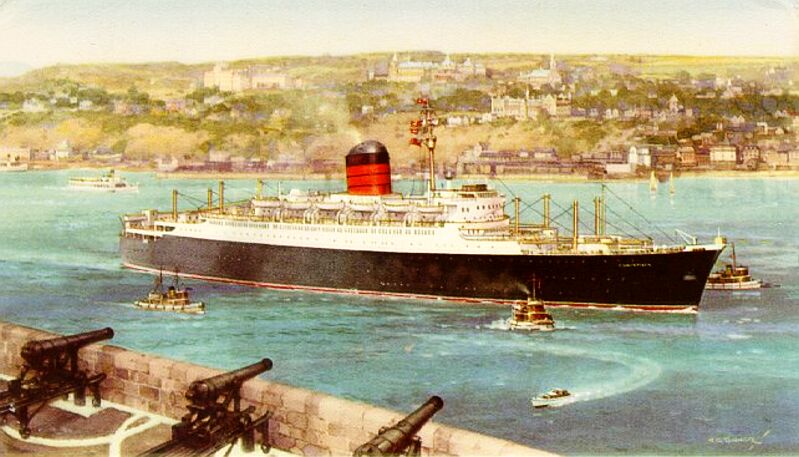
A superb illustration depicting the RMS Carinthia on
the St Lawrence River,
Canada
The same image as is used on the traditional Cunard
Carinthia postcard
From the author’s collection
Carinthia and Sylvania
like their sisters the Carmania ex Saxonia
and Franconia ex Ivernia’s careers were soon overtaken by air travel,
thus both ships were encountering severe financial losses and Cunard decided to
withdraw Carinthia and Sylvania
from service in December 1967. They were laid up in Southampton
and placed on the market. In 1968 they were purchased by the Italian Shipping
Company Sitmar Lines, and it will become obvious that their ocean going days
were far from over as this feature will reveal!
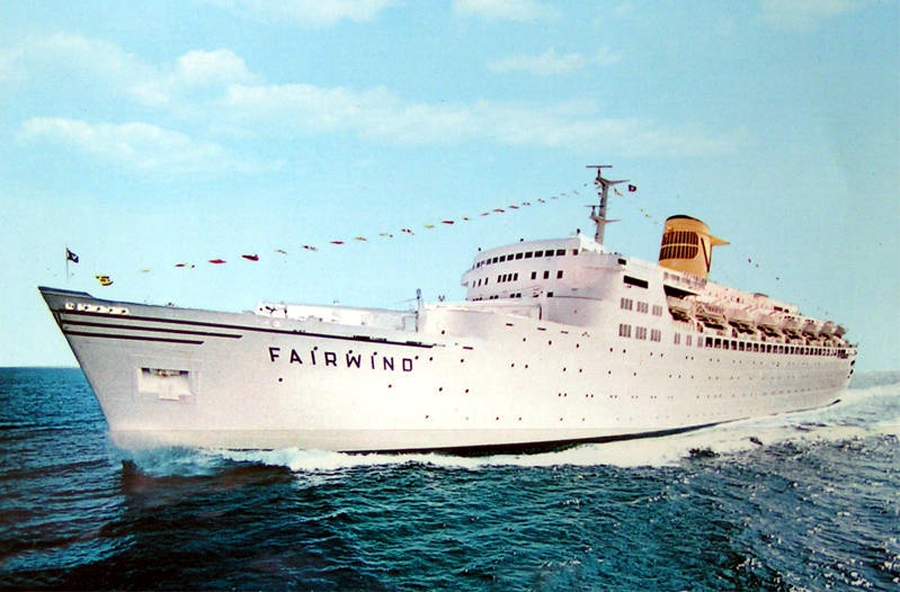
Sitmar Cruises newly
rebuilt 5 Star luxury cruise ship the, TSS Fairwind as seen in her first year
of 1972
From the author’s collection
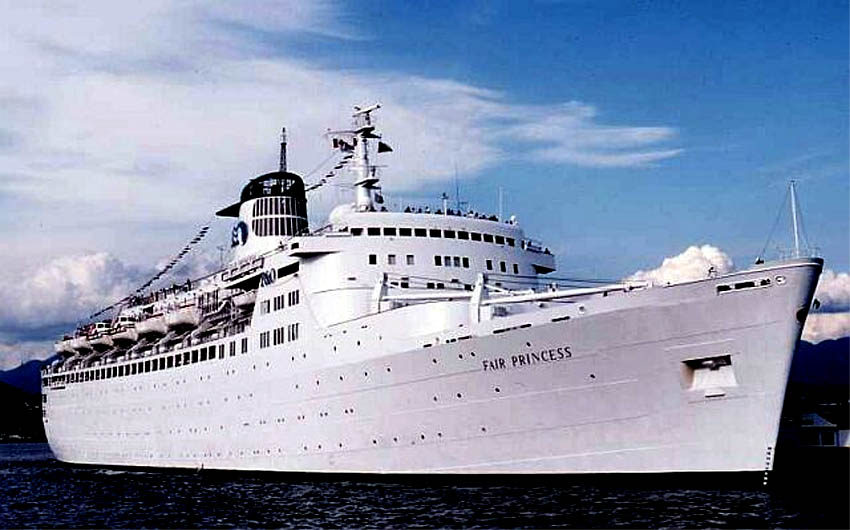
The ex RMS Carinthia
was re-launched as Sitmar Cruises superb, TSS Fairsea in 1971, but P&O
purchased Sitmar in 1988
and she became the
Princess Cruises’ Fair Princess and was a luxurious and a beautiful ship
indeed!’
From the author’s collection
Please Note: This feature is
currently being updated and this is the first page being worked on, thus all
pages following are yet to be done. Thus go and view them by all means, but return
in the future for there will be many new images and details!
Also note the NEW page: RMS Carinthia’s
Inaugural Brochure and that is really
a superb page, so full of pictorial history!
Index
Please Note - Each
page has a link to the next chapter
Page 1 – Foreword – Construction – NEW - RMS Carinthia’s Inaugural Brochure
Page 2 – Sitmar buys Carinthia
and Ivernia – Sisters go Russian
Page 3 - Fairwind / Fairsea
– Sitmar sold to P&O Princess Cruises
Page
4 – The Fairstar the Australian connection
Page
5 – Fair Princess becomes an Aussie
Page 6 – Passenger list
images
Page 7 – Albatros ex
Dawn Princess / Fairwind / Sylvania / Ivernia
Saxonia – Passenger list images
Fair
Princess Photo Album – Exteriors -
PLEASE NOTE: this page is being Updated:
Fair
Princess Photo Album - Interiors
Fedor Shalyapin
- ex Franconia /
Ivernia
China Sea Discovery –
ex Fair Princess / Fairsea / Fairland / Carinthia
China Sea Discovery Photo Album
China Sea Discovery Saga
Photographic Sources
on these pages
All photographs are by the
author, or from the
author's private collection, unless mentioned otherwise ~ Fairsea in Juneau
Alaska - Luca Ferrerio
~ Fair Princess (Princess Cruises) - Marvin Jensen ~ Pacific
Sky – Marion Carter ~ China Sea Discovery - Kiwi Marine
Consultants Ltd, Hong Kong ~ Photographer of Fedor Shalyapin laid up, and other
‘*unknown’ photographers - please see the photo notes at bottom of
page.
****************************************
Use
the Back button on your browser or Close the Page to return to the previous
page
or go to our INDEX
ssMaritime.com & ssMaritime.net
Where
the ships of the past make history & the
1914 built MV Doulos Story
Also visit my
Save The
Classic Liners Campaign
Photographs on ssmaritime
and associate pages are by the author or from the author’s private
collection. In addition there are some images that have been provided by
Shipping Companies and private photographers or collectors. Credit is given to
all contributors. However, there are some photographs provided to me without
details regarding the photographer/owner concerned. I hereby invite if owners
of these images would be so kind to make them-selves known to me (my email
address may be found on www.ssmaritime.com only), in order that due credit may be given.
This
notice covers all pages, although, and I have done my best to ensure that
all photographs are duly credited and that this notice is displaced on each
page, that is, when a page is updated!
ssMaritime is owned & © Copyright by Reuben
Goossens - All Rights Reserved









